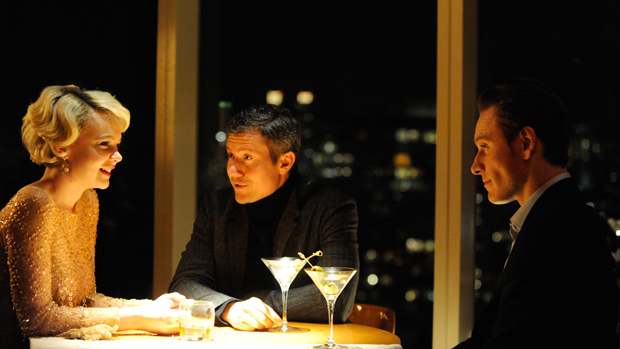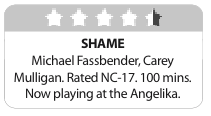‘Shame,’ British artist Steve McQueen’s intense look at a sex addict, delves into the dark

LET’S GET LOST | A sex addict (Michael Fassbender, right) deals with his disturbed sister (Carey Mulligan, left) in the provocatively sexual drama ‘Shame.’
ARNOLD WAYNE JONES | Life+Style Editor
jones@dallasvoice.com
For the first 20 minutes or so of Shame, the first NC-17-rated movie to get a legit theatrical release in awhile, not much happens — or rather, not much is said. We don’t even know that the man we are following (Michael Fassbender) is named Brandon. (We do, however, know he has a big wiener — there’s lots of full-frontal here.) We just know that he has a lot of sex. A lot. And not with the same women, or even the same kind of woman. He targets various races ages and types. We hear repeated voicemails from one woman he seems to have bedded and ignored; he pays for a call girl; he flirts with a married lady on a commuter train; he even jerks off alone in the shower. He doesn’t seem to discriminate, or even know anything about self-control.
But Brandon falls in a weird netherworld between contemptible cad and admirably effective womanizer. He doesn’t share much about his personal life, and his face doesn’t reveal much. When a business colleague uses a string of come-on lines to seduce a woman at a bar, Brandon stands back like an old panther, waiting for the eager cub to annoy the gazelle before he subtly strikes. The woman sees it coming. He isn’t a jerk, just sexually charismatic. He has patience.
 At least he does until his sister Sissy (Carey Mulligan) shows up. Their relationship is complex and disturbing (we first see Sissy, as Brandon does, fully naked in his shower) but we never fully know its details. She seems to show up out of nowhere every so often, this time as a Marilyn-esque torch singer whose performance hypnotizes the bar’s patrons and the movie audience as well.
At least he does until his sister Sissy (Carey Mulligan) shows up. Their relationship is complex and disturbing (we first see Sissy, as Brandon does, fully naked in his shower) but we never fully know its details. She seems to show up out of nowhere every so often, this time as a Marilyn-esque torch singer whose performance hypnotizes the bar’s patrons and the movie audience as well.
Indeed, “hypnotic” seems like the perfect word to describe Shame’s overall aesthetic. The writer-director, British artist Steve McQueen (no relation; he also made the gay-themed short Bear), uses blank cityscapes and cold, Edward Hopper-esque shots composed to suggest the deep-seated alienation of Brandon — and, by extension, all of us.
The intense, sterile interiors and scenes of everyday life — one reason we see Fassbender naked so much is he wanders from bedroom to toilet, takes a piss and brushes his teeth with the same routine we all do — make it resonate. McQueen has made a story that’s entirely specific yet universal, even as it makes us uncomfortable at its forced intimacy. It oozes desperation.
McQueen’s visual style is deceptive. One scene — the only honest “date” Brandon has in the movie, a dinner with a co-worker he’s been flirting with — is a single take, the camera largely static; another is an immense tracking shot, following Brandon on a jog through the streets of New York. The technique is dazzling but still doesn’t draw attention to itself. He’s a jumble of what works, moment to moment.
And virtually all of it works. Fassbender, cool as the back side of the pillow, plays brilliantly off of Mulligan’s frenetically unstable Sissy, as well as the emptiness of Brandon’s life. He’s chilling, and devastating as he undergoes painful self-examination.
The dark sexuality is the frankest since Blue Velvet, but it also sends mixed signals. A scene late in the film where Brandon crosses the last frontier and explores his repressed homosexuality is as explicit as you’re likely to see in a theater, but it also suggests a last-gasp, the point at which Brandon’s “shame” finally overcomes him. Or is it saying that the guilt he feels over his sexual exploits are confined to the hetero world — that gay hardcore subculture gets it right, and shame is an antiquated, bourgeois emotion? The film is perhaps too impenetrable to reveal itself in that way. That’s a shame.
This article appeared in the Dallas Voice print edition December 9, 2011.











